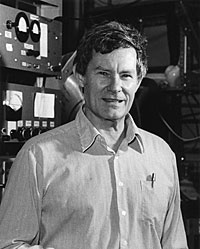John Gordon King
DOI: 10.1063/PT.3.2594
A passion for hands-on discovery marked the life of MIT physics professor emeritus John Gordon King, an imaginative experimental physicist and transformative physics educator. King is best known for his work with electricity and magnetism and for mentoring hundreds of students throughout his more than half-century career at MIT’s Molecular Beam Laboratory. He died at his summer home in Wellfleet, Massachusetts, on 15 June 2014.

John Gordon King
MASSACHUSETTS INSTITUTE OF TECHNOLOGY

King was born in London on 13 August 1925 and was educated in France, Switzerland, and the US. After serving in World War II, principally through the US Navy as a radio specialist in Harvard University’s Underwater Sound Laboratory, he went to study at MIT. He received his bachelor’s degree in 1950 and his PhD in 1953, both in physics. King joined the MIT faculty upon graduation and ran the freshman physics lab, which helped shape many of his ideas for inspiring young students. He was named Francis L. Friedman Professor of Physics in 1974 and retired in 1996.
As a doctoral student of Jerrold Zacharias, who began MIT’s Molecular Beam Laboratory, King measured the electric and magnetic multipole moments of atomic nuclei. He and Vincent Jaccarino discovered the magnetic octupole moment of iodine-127 in groundbreaking work in which they applied the precise and elegant molecular-beam techniques to the halogens. He also helped develop the atomic clock based on the hyperfine structure of cesium-133, converting a laboratory experiment into a commercial and reliable instrument that has become the universal time standard.
In the early 1960s, King became head of the Molecular Beam Laboratory. Committed to the interconnectivity of disciplines, he expanded the scope of the lab’s research to include cosmology, low-temperature physics, and biophysics. During his tenure, more than 100 undergraduate and 25 doctoral students earned degrees in those fields.
King is best known for his 1960 measurement of the charge magnitude equality of the electron and the proton and the neutrality of the neutron to 10−20 of an electron charge. That experiment, which still graces the first page of most electricity and magnetism textbooks, had been prompted by a conjecture that the expansion of the universe was due to a slight charge imbalance.
Combining cryogenic and molecular-beam techniques, in the late 1960s and early 1970s, King developed a series of experiments to explore the fundamental properties of superfluid helium by observing variations in evaporation and scattering behavior. An interest in pursuing the limits of microscopy led him to conduct theoretical and experimental studies to improve the resolution of electron microscopy to atomic dimensions. King branched into biophysics with his invention of a molecular microscope; for the illuminating projectile, he used water molecules rather than light.
King was deeply committed to improving science education at the high school and college levels. In the 1960s he worked with the influential Physical Science Study Committee, for which he produced and acted in eight movies, including Time and Clocks and Interference of Photons. In one film, King demonstrates a principle of physics by driving fast in one of his meticulously restored Bugatti automobiles.
Traditional laboratory “cookbook” exercises, King believed, bored students and stifled creativity and ingenuity. To address that, and to help students understand fundamental science concepts in the real world and not just in the classroom, he introduced methods that emphasized hands-on learning and independent thinking. In 1966 he started Project Lab for undergraduates to design their own open-ended research. He advised his students, “The best way to understand your apparatus is to build it.” In a 2009 oral history interview with the American Institute of Physics (http://www.aip.org/history/ohilist/33499.html
King found that studying various disciplines simultaneously was disruptive for most students, so he advocated for full immersion into one topic at a time. He convinced other faculty members to join him in offering a sequenced version of the standard MIT undergraduate curriculum. The model has since been used at many schools in their intersemester immersion courses.
Among King’s numerous publications is the upcoming book Physics Project Labs (Oxford University Press, December 2014), which he cowrote with Paul Gluck. His many honors and awards include a 1956 Alfred P. Sloan Award, the Danforth Foundation’s 1971 E. Harris Harbison Award, and the American Association of Physics Teachers’ 1965 Robert A. Millikan Medal and 2000 Oersted Medal, the organization’s most prestigious award.
Perhaps his most endearing quality as a physicist, witnessed by his students and many of his colleagues, was King’s unbridled enthusiasm for physics and new ideas. One could discuss a concept with him, and within minutes he would make drawings and estimates on the backs of envelopes and often invent an interesting and viable experiment on the spot. Ideas did not die when talking to King—rather, they flourished.
More about the Authors
H. Frederick Dylla. American Institute of Physics, College Park, Maryland.
Rainer Weiss. Massachusetts Institute of Technology, Cambridge.
